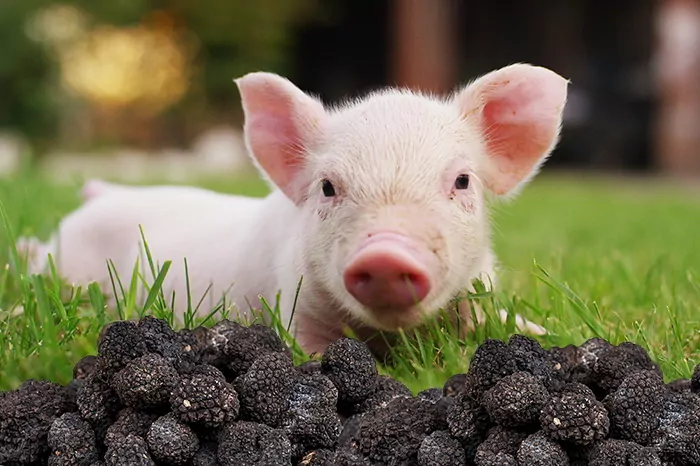What Hollywood Doesn’t Tell You About Pigs (And Profits)
“Who has my pig?”
These words are uttered by desperate Oregon recluse Rob, played by Nicolas Cage, in the recently released movie Pig.
“Hmmm… a lost pig,” you may think. “Can that be a movie? I mean, a movie for adults?”
Yes, indeed. Especially when the animal in question is a truffle-hunting pig… worth some US$25,000. (Of course, it goes much deeper than that for the owner.)
Here’s what Hollywood doesn’t tell you though…
Pigs were traditionally used to hunt down truffles. But more plantations these days employ specially trained dogs to do the work. Really, pigs are better at sniffing out this luxury tuber, but they’re also more likely to gobble their newly found treasure…
What’s more, if you’re a truffle farmer in Italy, you can’t just release Babe on a quick sniffing mission. Because pigs inflict so much damage to the ground, the Italian government banned their use in the industry back in the 1980s.
The best dog for the job is the Lagotto Romagnolo, an Italian breed, also known as the “truffle hunter.”
Of course, whether the truffles are found by pig or dog doesn’t really matter to the foodie. Today, truffles are in high demand by fine diners the world over…
Chefs will pay as much as US$30 to US$75 per truffle.
Adding truffle shavings to a risotto dish can add an extra US$60 to US$100 on to your restaurant check…
The problem is—and this is where the opportunity lies for investors—supply is nowhere close to meeting demand…
Hence the exorbitant prices for the best-quality truffles.
Can’t We Just Farm More Truffles?
Truffles can grow under the roots of certain trees. But they are not easy to produce.
Not only do you need the right climate conditions, but too many competing fungi in the ground can threaten a truffle harvest. Southern and Central Europe have the upper hand on climate. But even then, you can’t depend on Mother Nature alone…
Spain, for instance, is responsible for 38% of black Périgord truffle production. But, in the 2012-2013 season, Spain had a no-show. Anybody else in the world who could find a black Périgord (aka “black diamond”) was paid double the previous season’s price.
So, to begin to scratch the surface of this rising global demand, you can’t rely on wild-grown truffles alone.
That’s not what we’re here to talk about today.
Nor are we bothered with the cheap Asian-produced truffles that have made their way into the market—only to be frowned upon by the higher echelons of European society for the “doping” involved to make the truffles smell like the real thing.
Instead, you have the opportunity, right now, to invest in a Europe-based plantation that’s focused on providing the right conditions to produce hectare after hectare of high-quality black Périgord truffles…
You may remember this opportunity from a previous alert. Maybe you attended the truffle presentation at our recent Global Property Virtual Summit. But I wanted to bring it to your attention again today, because two things are at stake…
First, as happens with most projects as they grow, the developers are preparing to increase their prices in the coming weeks. So, you have a short window to get in at the early pricing LIOS readers have been enjoying the past few years.
Second, for a limited time, the developers are offering LIOS readers a special discount on their truffle investment.
Get Started With A Minimum Of 50 Trees—And An Exclusive Discount
This is a chance to diversify into an agri-investment where you become the owner of a set of trees… and, eventually, owner of the truffles that all the farming around those trees works hard to produce.
You will never have to plant a tree… or dig for truffles. After your one-time payment, you sit back and wait for your profits… year after year.
Cash flow starts as early as year 3 and is projected to grow over time to as much as a 50% annual yield by year 15… and continue at that level for the next 15 years.
Last year, even in the middle of a pandemic, prices for these black Périgord truffles soared. Readers who invested in the early days recently received their first payout—which came in at 22% above the projected returns.
You can get started with as little as 50 trees which, over 30 years, will pay you a projected total net return of US$372,112.
Stretching to a 100-tree investment increases your projected total return to US$752,414. Larger plots are available, too, to support more trees… with projected returns reaching seven figures.
If you’d like to find out more about how you can cash in on the insane demand for this luxury food—and get a generous discount on your own collection of truffle-supporting trees—be sure to join us for a special spotlight event coming up next Tuesday, Sept. 28…
This event is a chance to find out all the details and ask your questions… in real time. And, if you decide it’s for you, you’ll be able to take advantage of your attendee-only discount.
Registration for this online event is now open. Secure your free spot here.
Lynn Mulvihill
Editor, Overseas Property Alert

